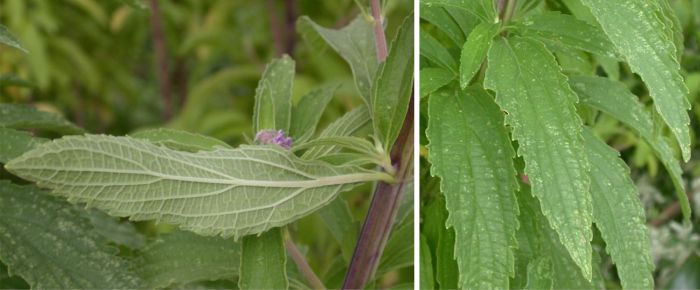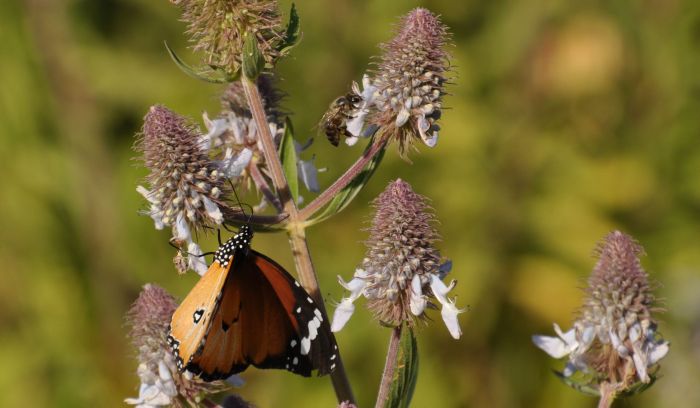Coleus kirkii
Coleus kirkii (Baker) A.J.Paton (= Pycnostachys reticulata (E.Mey.) Benth.)
Family: Lamiaceae
Common names: prickly sage, blue soldier sage (Eng.); stekelsalie (Afr.); umvuthuza, uhlalawane (Zulu)
Introduction
A beautiful perennial with two-tone, spiky, pale blue and mauve flowerheads in late summer to autumn; a good choice for the mixed border if you live in a frost-free area.

Description
Description
Coleus kirkii is a robust, upright-growing, herbaceous shrub that reaches a height of 1.5 to 2 m. The leaves are opposite, narrowly lanceolate, with irregularly toothed margins and a very short stalk. When they are both not in flower, it could be mistaken for Leonotis leonurus (Lion’s Ear, Wild Dagga) as they have a similar growth habit and similar-looking foliage.

Coleus kirkii has pale blue and mauve flowers densely crowded into short, spiky spikes, about 50 mm long and 20 mm wide. The inflorescence is terminal on the main or lateral branches. The spikiness comes from the fact that the calyx is made up of 5 spike-like lobes that protrude beyond the buds and are a noticeable feature of the inflorescence.

The inflorescence is made up of mauve-blue buds amongst the reddish-purple spikes of the calyx. The flowers open from the bottom of the inflorescence upwards, forming a pale blue ring around the inflorescence. If you look closely you can see that the flowers are typically salvia-like, with a 2-lipped tube; the lower lip is large and boat-shaped and longer than the upper lip. At Kirstenbosch the plants show some variation in colour, some have pale mauve flowers with pinkish-purple calyx spikes, and at the other end of the scale they have dark reddish-purple spikes and bluish-mauve flowers. Flowering time at Kirstenbosch is late-summer to autumn (March-April). The seed is a small, ovoid nutlet.
Conservation Status
Status
Least Concern (LC). Coleus kirkii is not threatened.
Distribution and habitat
Distribution description
Coleus kirkii is a widespread species. It occurs in South Africa in the provinces of the Eastern Cape, KwaZulu-Natal, Mpumalanga, Gauteng, North West and Limpopo, and in Mozambique, Eswatini, Zimbabwe and northwards as far as Tanzania, Cameroon and Nigeria. It grows in moist, swampy places and in grassland.

Derivation of name and historical aspects
History
The name Coleus is derived from the Greek koleos, meaning ‘a sheath’, and refers to the fused stamens of the type species for the genus, and a character that at one time was thought to be diagnostic for this genus. Its species name honours Dr John Kirk (1832-1922) who collected a specimen of our species in Manganja Hills. Kirk was a medical doctor who was also a keen botanist. He was born in Scotland, joined Livingstone’s second expedition where he made many field drawings and was among the first to photograph the vegetation in the Zambezi Valley. He collected many plant specimens and has many species named after him, including Dombeya kirkii, Kirkia acuminata, Diospyros kirkii, Cleistochlamys kirkii and Maerua kirkii.
Coleus kirkii previously was placed in the genus Pycnostachys, the name meaning ‘dense spike’, from the Greek pyknos meaning ‘dense’, and stachys actually ‘an ear of corn’ but in botany ‘a spike’ and referring to the inflorescences. It was moved into the genus Coleus in 2019 after molecular studies on Plectranthus and closely related genera by Paton et al showed that the old definition of the genus Plectranthus did not have a single common ancestor, and that it contained two distinct clades separate from Plectranthus. The one clade including the type species of the former genus Coleus, which led to the re-instatement of the genus Coleus, and the other that is now recognized as the new genus Equilabium. A new, smaller, Plectranthus was redefined. The study also showed that the genera Pycnostachys, Anisochilus, Leocus and some species of Solenostemon belong inside the Coleus clade.
When it was moved into Coleus, this species lost its previous species name reticulata because there is already a Coleus reticulatus in western Africa. Reticulata means ‘netted’ or ‘a network’ in Latin, and referred to the veins, which are clearly visible on the underside of the leaf. Our species name reverted to the next oldest valid name, Pycnostachys kirkii, which had been sunk into synonymy under Pycnostachys reticulata.
All species of Pycnostachys have been transferred to Coleus. Only 3 of them occur in South Africa: Pycnostachys reticulata now Coleus kirkii, Pycnostachys urticifolia now Coleus livingstonei and Pycnostachys coerulea now Coleus stenostachys. At Kirstenbosch we grow Coleus kirkii and C. livingstonei, the latter is commonly known as the hedgehog sage, blue boys, nettle-leaf pycnostachys, dark blue pycnostachys, ystervarksalie (Afr.), amadata or unkungwini (Zulu). Its leaves are markedly different, greener, broader, almost triangular with rounded teeth and the flowers are a bright gentian blue or pale blue or white. It occurs in moist places along grassy streambanks and forest margins in Limpopo, Mpumalanga as well as Zimbabwe, Mozambique, Eswatini and Tanzania.
Ecology
Ecology
Coleus kirkii is a larval food plant for the Marsh Commodore butterfly, Precis ceryne and the flowers are visited by bees and butterflies at Kirstenbosch NBG.

Uses
Use
Coleus kirkii roots are used in traditional medicine as a mouthwash for teeth suffering from neuralgia (nerve pain), not decay. In the Democratic Republic of the Congo, a species indigenous to that region, C. erici-rosenii is used in traditional medicine in combination with other plants to treat rabies, madness, anaplasmosis, gastro-enteritis, diarrhoea, dysentery, coccidiosis and schistosomiasis.

Growing Coleus kirkii
Grow
Coleus kirkii is easy to grow, not that fussy about soil and can withstand periods of drought, but does best in fertile, well-drained soil in full sun or part shade with ample water. It can be pruned hard after flowering and it will resprout strongly in the spring. Although it is frost tender, it should be able to survive short cold snaps but not prolonged exposure to freezing temperatures.
Coleus kirkii is a good plant for the mixed border, where it provides a striking two-tone colour effect. The flowering stems are long and good for cutting.
It can be propagated by seed sown in spring or early summer, or by heel or tip cuttings taken in spring or early summer.
References
- Chifundera, K. 1998. Livestock diseases and the traditional medicine in the Bushi area, Kivu Province, Democratic Republic of Congo. African Study Monographs, 19,1: 13-33.
- Haxen, P. 2017. Mpondaminga on the dyke: Sunday April 20th 1986. Tree Life, issue 444, Tree Society of Zimbabwe. https://treesociety.org.zw/tree-life/444/ Accessed on 2020/01/30
- Hutchings, A., Scott, A.H., Lewis, G. & Cunningham, A.B. 1996. Zulu medicinal plants: an inventory. University of Natal Press, Pietermaritzburg.
- Paton, A.J., Mwanyambo, M., Govaerts, R.H.A., Smitha, K., Suddee, S., Phillipson, P.B., Wilson, T.C., Forster, P. I. & Culham, A. 2019. Coleus and Plectranthus (Lamiaceae): a tale of more than two genera. Phytokeys 129: 1–158.
- Pole Evans, I.B. 1933. Pycnostachys purpurascens. The Flowering Plants of South Africa 13: t. 513.
- Pooley, E. 1998. A field guide to wild flowers Kwazulu-Natal and the eastern region. Natal Flora Publications Trust, Durban.
Credits
Alice Notten
Kirstenbosch National Botanical Garden
March 2004
updated June 2020
Plant Attributes:
Plant Type: Perennial
SA Distribution: Eastern Cape, Gauteng, KwaZulu-Natal, Limpopo, Mpumalanga, North West
Soil type: Loam
Flowering season: Late Summer, Autumn
PH:
Flower colour: Blue, Purple, Mauve/Lilac
Aspect: Full Sun
Gardening skill: Easy
Special Features:
Horticultural zones











Rate this article
Article well written and informative
Rate this plant
Is this an interesting plant?
Login to add your Comment
Back to topNot registered yet? Click here to register.